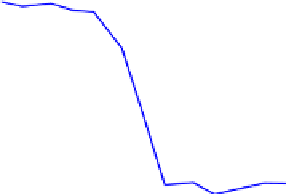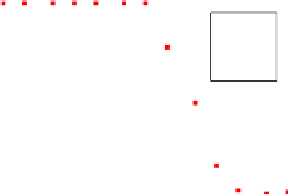Information Technology Reference
In-Depth Information
1
1
d
=0
d
=1
d
=4
d
=10
0.8
0.8
0.6
0.6
0.4
d
=0
d
=1
d
=4
d
=10
0.4
0.2
0.2
0
10
−3
10
−2
10
−1
10
0
10
1
10
−3
10
−2
10
−1
10
0
10
1
r
r
(a)
(b)
Fig. 17.6. (a) Order parameter v
a
vs. for dierent . Other parameters are N = 100, N
i
= 10,
r
r
= 0:3, r
o
= 0:8, r
a
= 1, ! = 0:3, = 0:03. Each simulation is for T = 250s. (b) Order
parameter v
d
vs. with respect to dierent values of . Other parameters are as in Fig. 17.6(a).
For high density, v
a
tends to become independent of the number of long-range
connections. In fact, when the density is high, the agents are close to each other and
are mainly engaged in performing avoidance. Therefore, the advantages introduced
by long-range connections are more important at low density as observed in the
Vicsek's model.
The eects of long-range connections on the parameter v
d
are similar. In fact,
the presence of long-range connections causes an increase of the value of v
d
, which
means that the mean motion direction of the group tends to be similar to the
preferential motion direction adopted by informed individuals. Fig. 17.6(b) shows
v
d
as a function of with respect to dierent values of : long-range connections
favor the tendency to form a group with a homogeneous direction, thus enhancing
leadership of informed individuals. As in Vicsek's model, this is eective only at
low density values.
Figures 17.6(a) and 17.6(b) refer to the case of ten informed individuals (N
i
=
10). In the following, we address the case of increasing the number of informed
individuals. Figures 17.7(a) and 17.8(a) show that v
a
and v
d
increase with N
i
in
absence of long-range connections. The advantages of having a high percentage of
informed individuals are clear at low density values, where groups mainly consti-
tuted by informed individuals form. For higher density, increasing the number of
informed individuals has small eects on v
a
and v
d
. Figures 17.7(b) and 17.8(b)
show v
a
and v
d
in the presence of long-range connections. The introduction of
long-range connections has greater eects when N
i
is small. On the other hand,
increasing the number of N
i
in presence of long-range connections does not show
great improvements, unlike the case with = 0. Furthermore, when = 0 the
transition between high values of v
d
and low values of v
d
is sharper than in the case












































